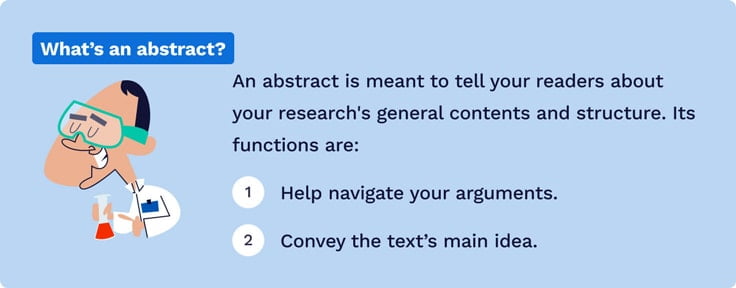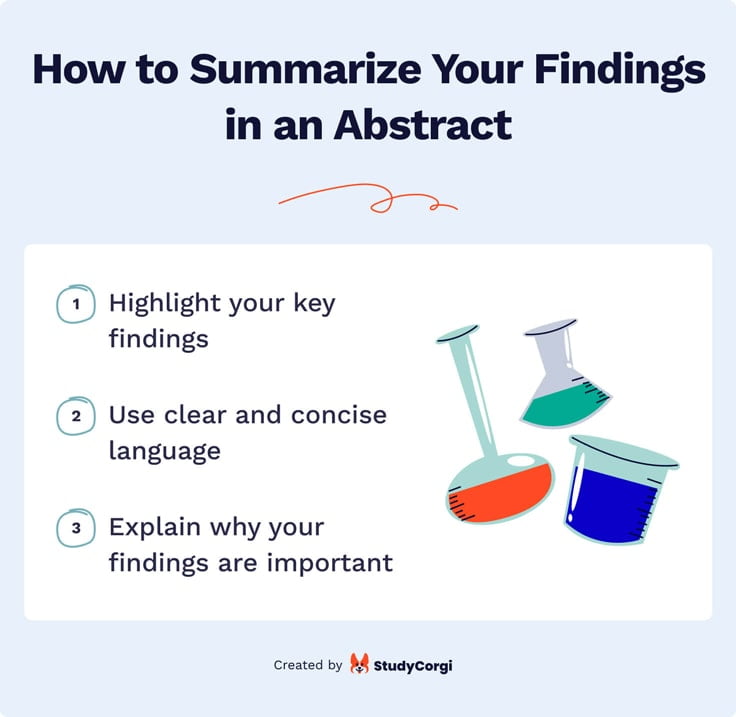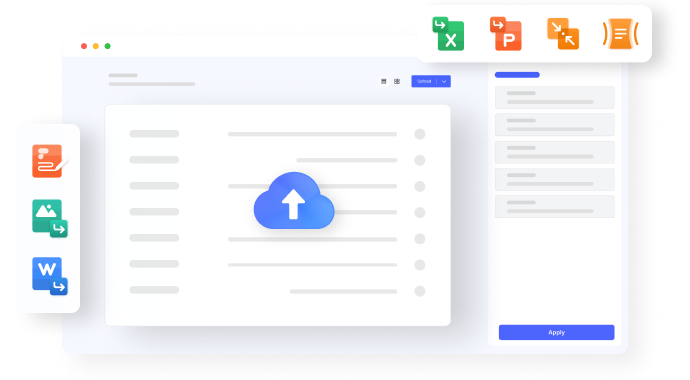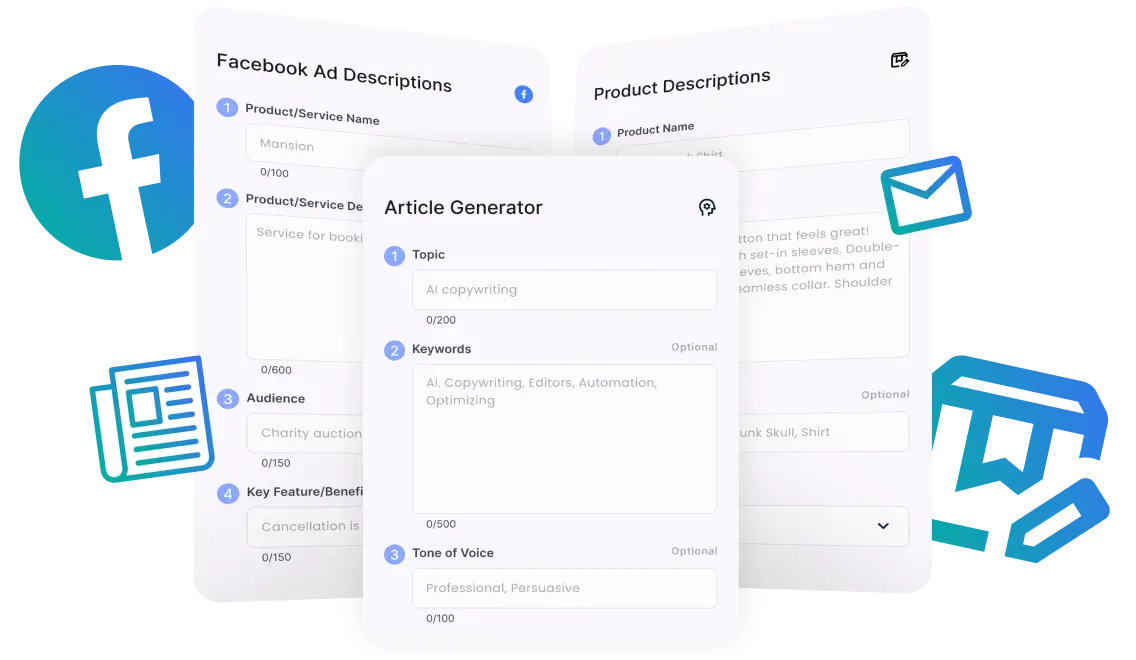

Abstract Generator
Get your abstract written – skip the headache., writefull's abstract generator gives you an abstract based on your paper's content., paste in the body of your text and click 'generate abstract' . here's an example from hindawi., frequently asked questions about the abstract generator.
Is your question not here? Contact us at [email protected]
What are the Abstract Generator's key features?
Load Sample
Title is Here
Your abstract is here
- Abstract Generator
Abstract generator lets you create an abstract for the research paper by using advanced AI technology.
This online abstract maker generates a title and precise overview of the given content with one click.
It generates an accurate article abstract by combining the most relevant and important phrases from the content of the article.
How to write an abstract for a research paper?
Here’s how you can generate the abstract of your content in the below easy steps:
- Type or copy-paste your text into the given input field.
- Alternatively, upload a file from the local storage of your system.
- Verify the reCAPTCHA.
- Click on the Generate button.
- Copy the results and paste them wherever you want in real-time.
Features of Our Online Abstract Generator
Free for all.
Our abstract generator APA is completely free for everyone. You don’t have to purchase any subscription to abstract research papers and articles.
Files Uploading
To get rid of typing or pasting long text into the input box, you can use this feature.
This will allow you to upload TXT, DOC, and PDF files from the local storage without any hurdles.
Create Abstract and Title
This abstract creator online makes it easy for you to generate a title and precis overview of the given text with one click.
It takes the important key phrases from the content and combines them to create an accurate abstract with advanced AI.
Click to Copy
You can use this feature of our online abstract maker to copy the result text in real-time and paste it wherever you want without any hassle.
Download File
This feature lets you download the abstracted text in DOC format for future use just within a single click.
No Signup/Registration
This free text abstraction tool requires no signup or registration process to use it. Simply go the Editpad.org , search for the Abstract Generator, open it, and enter your text to create an abstract of any text within seconds.
Other Tools
- Plagiarism Checker
- Paraphrasing Tool
- Reverse Text - Backwards Text Generator
- Small Text Generator - Small Caps / Tiny Text
- Upside Down Text Generator
- Words to Pages
- Case Converter
- Online rich-text editor
- Grammar Checker
- Article Rewriter
- Invisible Character
- Readability Checker
- Diff Checker
- Text Similarity Checker
- Extract Text From Image
- Text Summarizer
- Emoji Translator
- Weird Text Generator
- Stylish Text Generator
- Glitch Text Generator
- Cursive Font Generator
- Gothic Text Generator
- Discord Font Generator
- Aesthetic Text Generator
- Cool Text Generator
- Wingdings Translator
- Old English Translator
- Online HTML Editor
- Cursed Text Generator
- Bubble Text Generator
- Strikethrough Text Generator
- Zalgo Text Generator
- Big Text Generator - Generate Large Text
- Old Norse Translator
- Fancy Font Generator
- Cool Font Generator
- Fortnite Font Generator
- Fancy Text Generator
- Word Counter
- Character Counter
- Punctuation checker
- Text Repeater
- Vaporwave Text Generator
- Citation Generator
- Title Generator
- Text To Handwriting
- Alphabetizer
- Conclusion Generator
- List Randomizer
- Sentence Counter
- Speech to text
- Check Mark Symbol
- Bionic Reading Tool
- Fake Address Generator
- JPG To Word
- Random Choice Generator
- Thesis Statement Generator
- AI Content Detector
- Podcast Script Generator
- Poem Generator
- Story Generator
- Slogan Generator
- Business Idea Generator
- Cover Letter Generator
- Blurb Generator
- Blog Outline Generator
- Blog Idea Generator
- Essay Writer
- AI Email Writer
- Binary Translator
- Paragraph Generator
- Book Title generator
- Research Title Generator
- Business Name Generator
- AI Answer Generator
- FAQ Generator
- Sentence Expander
- White Space Remover
- Remove Line Breaks
- Active to Passive Voice Converter
- Passive to Active Voice Converter
Supported Languages
- Refund Policy
Adblock Detected!
Our website is made possible by displaying ads to our visitors. please support us by whitelisting our website.
What do you think about this tool?
Your submission has been received. We will be in touch and contact you soon!
Free Abstract Generator
Make an abstract for your paper in 4 steps:
- Choose between a simple and an advanced option
- Paste the text or add the details
- Click “Generate”
- Check and copy the result
Your abstract may be:
- ⭐️ The Tool’s Benefits
- 🤔 Why Use Our Tool?
📝 What Is an Abstract?
- ✍️ How to Write It
- ✨ Abstract Example
🔗 References
⭐️ abstract generator: the benefits, 🤔 why use online abstract generator.
Having trouble writing an abstract? You’re not alone.
Crafting an abstract can be problematic, especially when dealing with voluminous work. After all, converting a 100-page academic paper into 150 words is not an easy task. And this is where an abstract maker can help you immensely.
The amount of time you’ll save by relying on a machine to do the work for you is huge. Not to mention the result will be entirely error-free. No logical, grammatical, or other mistakes will spoil your piece.
Sounds interesting? Then, keep reading to learn more about abstracts and our generator.
An abstract is a brief summary of a work. Usually, it's a single paragraph containing 150 to 250 words. It describes all the key points and elements of an article, essay, or work of any other format.
Keep in mind that an abstract merely describes a text. It shouldn’t be an evaluation or an attempt to defend the paper. Instead, it’s just an overview.
Structure of an Abstract
An abstract is not a simple summary. It has a specific structure and should contain the following elements:
Remember that an abstract is separate from the rest of the paper. For the reader to get the complete picture of your research, your abstract must include everything listed above.
✍️ How to Write an Abstract
It can be tempting to go and write an abstract right away. But make sure to finish the planning of your work first. You want to write your abstract about your piece's contents, not build the contents around your abstract.
To make the writing process easier, divide it into 5 manageable steps:
- Check the requirements. First off, you need to know how much you are allowed to write. An average abstract is about 150-250 words long, but there is often a strict limit. Make sure to stay within it!
- Establish the goal and the problems of the research. The reader needs to know what your paper will be about right from the get-go. That’s why you need to formulate your thesis and showcase it first.
- Establish the methods. Tell the reader how you did your research. Don’t go in too deep: simply describe the methods without unnecessary details.
- Describe the results. Write a couple of sentences about the outcome of your investigation.
- Write a conclusion. Address the issue you established in the second step. You might also want to mention your work’s limitations regarding your research samples or methods. Try to give the reader a clear understanding of your goal and how you achieved it.
Want to make the process even easier? Use our abstract tool! Online generators like ours will help you craft an excellent paragraph in a matter of seconds.
Abstract Writing Tips
Finally, we want to help you make your abstract truly amazing. Check out our best tips below:
- It's best to get to the point immediately and without adding any filler or unnecessary details.
- The less specific your abstract is, the better.
- Check out some examples before you start writing. Sometimes the best way to learn something is to watch how everyone else does it.
- Avoid long sentences or bizarre vocabulary to make an abstract paragraph as concise as possible.
- It’s a great idea to single out some keywords from your outline and put them into your abstract.
- Don't forget about formatting. Any serious academic work has its requirements. Make sure you check them before writing your piece.
Following these simple tips will make you a master of abstract writing.
✨ Free Abstract Sample
As an example, check out this abstract of the article “Bioeffcacy of Mentha piperita essential oil against dengue fever mosquito” by Sarita Kumar:
The Mentha balsamea, or peppermint plant, is a result of cross-breeding between spearmint and water mint. These plants are most commonly used in the area of repelling insects. The following research revolves around peppermint oil insect repellent and its development. As a part of an experiment, we obtained 25 grams of fresh peppermint and, after grinding it, put it in a glass jar with olive oil. The jar was then left for two days in a warm temperate. Next, the oil was strained with a cheesecloth, gathered, and diluted at 70%. It then got separated into three different spray bottles. The test was to put the spray sample into a jar with mosquitoes and equate the result to the same test with a commercial repellant. Thus, we challenged the stereotype of synthetic repellents being more efficient than their analogs made from natural materials.
That will be the end of our guide on abstract writing. Thank you for reading, and make sure to try out our abstract writer tool to get the best results!
❓ Abstract Generator FAQ
❓ how do you write an abstract for a research paper.
You may use an abstract tool and make the writing process entirely automatic. If you can’t use it, write an abstract yourself by describing the following:
- The main problem.
- Background information.
- The end goal.
- Description of methods you used.
- The results of the research.
❓ What are the 5 parts of an abstract?
Parts of an abstract depend on the contents and limitations of your research. The 5 main elements are:
- The introduction
- Research significance
- Method description
❓ What makes a good abstract in a research paper?
A good abstract is one that:
- Meets all the requirements.
- Establishes the problem and main issues of the research.
- Describes the methods you used during the analysis.
- Showcases results of the study.
- Provides a clear conclusion.
❓ How long should my abstract be?
An average abstract is about 150-250 words long. You may often get strict limits that can go above or beyond these numbers. Your supervisor should provide the exact requirements for abstract length. So, make sure to double-check them.
Updated: Apr 9th, 2024
- Writing an Abstract: George Mason University
- Writing an Abstract for Your Research Paper: University of Wisconsin - Madison
- Writing an Abstract: Australian National University
- The Abstract: The University of Toronto

Abstract Generator
This Abstract Generator is basically a guideline for writing abstracts. We have also written an article on how to write abstracts. Go through the post and use our tools to create properly formatted abstracts. Note: An abstract should be between 100 - 250 words.
Free Abstract Generator for Research Papers
- 🚀 Meet Our Abstract Generator
📃 What Is an Abstract?
- ✍️ How to Write an Abstract
- 🫣 7 Mistakes You Should Avoid
🔗 References
🚀 meet our abstract generator for research papers.
The abstract provides a brief overview of the research assignment. So, this part gives a general assessment of the work and encourages the reader to explore it further. Almost every student dealt with the difficult task of condensing their research results into several hundred words. But that’s not a problem anymore!
We used artificial intelligence to make a tool that will make your academic life more enjoyable . You can get an excellent example of an abstract specifically for your research paper in minutes. To do this, you need to specify the reason for the research, the problems, and the goals. Also, we recommend mentioning the methodology and your findings to ensure the outcome is accurate. After that, the AI abstract maker will do the rest for you!
Key Reasons to Use Our Online Abstract Generator
Students juggle various assignments and obligations. Research papers are among the most challenging tasks they have to complete. What makes them so difficult is the sheer volume of information and study involved. Dealing with large amounts of material often leaves students drained and incapable of summarizing their work correctly.
Our abstract generator for research papers makes this process more straightforward thanks to several factors:
Abstracts provide short summaries of larger works, including research papers and dissertations. Readers scan them to decide whether or not they wish to continue reading the rest of the paper. In about 150–200 words, you should state the problem and provide the research goal, results, implications, and used methods.
One should write research abstracts only after the rest of the work is ironed out and ready. While this part of research may seem insignificant, students should take the time to write the abstract well. Doing so lets them identify any flaws in the research methodology and results.
Types of Research Paper Abstracts
Many students believe that abstracts come only in one type. In reality, there are several versions of summaries used in academic circles.
- Critical Abstract . These are the most extensive abstracts, at around 450 words. Unlike other entries on this list, they encourage deep analysis: for example, a discussion about the validity or reliability of their studies. It’s mostly used in social science research .
- Descriptive Abstract . This format is quite similar to informative abstracts but much shorter. On average, this type is only 100 words long and covers the main focus of the studies. Descriptive summaries offer no conclusions or recommendations for further research.
- Highlight Abstract . Students rarely get to use this type, as its primary goal is to get the reader’s attention. Highlight abstracts don’t helpfully summarize papers . Instead, they concentrate on the unique parts of the research, such as its results and conclusions.
- Informative Abstract . This is the most common type used by researchers and writers. It provides primary information about research concepts, methodology, findings, and recommendations. Sometimes, informative research abstracts have keywords listed at the bottom, but this practice is mainly reserved for professional publications.
✍️ How to Write an Abstract in 5 Steps
Despite the incredible versatility of our abstract generator, it’s still important to learn how to make abstracts on your own. We’ve dedicated this part of the guide to the five steps of writing these summaries. So, these instructions will help you create an abstract for any academic paper.
- Write the paper . To create an abstract, you first need a research paper. Create an outline of the study detailing the problem and methods you’ll use to address it. Explain the research methodology, state what information can be extracted from it, and show how the findings apply to the overall field of study.
- Review paper requirements . Once you’re done with the draft, review the criteria provided by the educational institution. Use the supporting documents with instructions, as they can clarify the requirements for the work's style, formatting, and length. Different disciplines require specific styles, so read this information carefully.
- Consider the audience . When working on an abstract, it’s crucial to identify who will be reading it afterward. For example, students often adjust their language to reach the general public and not only their respective professors.
- Write the abstract . Now, write the abstract based on the provided requirements. Use the body of the research to summarize the problem, explain the methods used in the paper , and show what their results were. Finish the summary by telling why your findings are valuable to the study field and what can be done in further research.
- Iron it out . Like with all writing pieces, it's essential to review the abstract and check if it has all the necessary components. The text should be easy to follow, cover all points, and be informative. As the abstract creates the first impression, make it a good one.
Abstract Formats: MLA & APA Styles
Abstract types aren’t the only things students should look out for. In academic settings, several formatting styles detail how the text should look on paper. The majority of US colleges use two popular methods: MLA and APA . Here, we discuss how abstracts look in each of them.
🫣 7 Mistakes You Should Avoid When Writing an Abstract
Writing abstracts is a pretty straightforward process. But it doesn’t mean that everybody is immune from making mistakes, especially after spending days toiling away on a research paper.
There are seven common errors everybody should check before submitting an abstract.
- Making it too long . A summary should concisely describe the whole paper. Avoid repetition and details that have little to do with the research.
- Using chopped-up sentences . Ensure that your paper contains only complete sentences. It makes the work more professional and easier to comprehend.
- Adding too much technical jargon . Keep things simple so that anyone reading the abstract understands what it’s about. It will also make more people check out your paper.
- Not correcting the text . Sometimes, students want to finish a work without editing it too much. Take the time and comb the document for errors and factual mistakes.
- Failing to explain the significance of the research . The first couple of sentences should give readers a clear understanding of why the study is essential.
- Using the wrong tense . It’s recommended that abstracts be written in the past tense. Some academic institutions won’t accept papers with improperly written abstracts.
- Too many adjectives and hyperboles . You aren’t writing a 19th-century novel but an academic paper. The work should reflect that, so avoid using too many literary devices .
We hope you’ve found this article interesting and helpful in your academic pursuits. We also suggest taking a look at our guide for creating an excellent research paper . If you have any more questions about the art of writing abstracts, check out the FAQ section below.
❓ Research Abstract Generator – FAQ
- It’s written for the right audience.
- It's in the past tense and third person.
- Stands alone on the page.
- Has keywords and critical references.
- Reason for writing it and the importance of the research.
- Problematics the work attempts to solve.
- Methodology behind the study.
- Results backed by specific data.
- Practical and theoretical applications of the findings.
Updated: Oct 25th, 2023
- What Exactly is an Abstract? – Regents of the University of Michigan
- Abstract and Keywords Guide. – American Psychological Association
- Writing an Abstract. – The University of Melbourne
- Six Steps to Write an Abstract. – The University of Alabama
- How To Write an Abstract in 7 Steps (With an Example). – Indeed
- MLA Formatting: How Do I Do: An Abstract. – Warner Pacific University Library
- Abstracts. – The Writing Center, University of North Carolina at Chapel Hill
- Free Essays
- Writing Tools
- Lit. Guides
- Donate a Paper
- Referencing Guides
- Free Textbooks
- Tongue Twisters
- Job Openings
- Expert Application
- Video Contest
- Writing Scholarship
- Discount Codes
- IvyPanda Shop
- Terms and Conditions
- Privacy Policy
- Cookies Policy
- Copyright Principles
- DMCA Request
- Service Notice
This article offers an excellent generator for students to craft compelling abstracts. Also, you can explore our guide and tips on writing an abstract for research papers. Learn how to streamline the abstract-writing process and ensure your work gets the attention it deserves.
Writing an Abstract for Your Research Paper
Definition and Purpose of Abstracts
An abstract is a short summary of your (published or unpublished) research paper, usually about a paragraph (c. 6-7 sentences, 150-250 words) long. A well-written abstract serves multiple purposes:
- an abstract lets readers get the gist or essence of your paper or article quickly, in order to decide whether to read the full paper;
- an abstract prepares readers to follow the detailed information, analyses, and arguments in your full paper;
- and, later, an abstract helps readers remember key points from your paper.
It’s also worth remembering that search engines and bibliographic databases use abstracts, as well as the title, to identify key terms for indexing your published paper. So what you include in your abstract and in your title are crucial for helping other researchers find your paper or article.
If you are writing an abstract for a course paper, your professor may give you specific guidelines for what to include and how to organize your abstract. Similarly, academic journals often have specific requirements for abstracts. So in addition to following the advice on this page, you should be sure to look for and follow any guidelines from the course or journal you’re writing for.
The Contents of an Abstract
Abstracts contain most of the following kinds of information in brief form. The body of your paper will, of course, develop and explain these ideas much more fully. As you will see in the samples below, the proportion of your abstract that you devote to each kind of information—and the sequence of that information—will vary, depending on the nature and genre of the paper that you are summarizing in your abstract. And in some cases, some of this information is implied, rather than stated explicitly. The Publication Manual of the American Psychological Association , which is widely used in the social sciences, gives specific guidelines for what to include in the abstract for different kinds of papers—for empirical studies, literature reviews or meta-analyses, theoretical papers, methodological papers, and case studies.
Here are the typical kinds of information found in most abstracts:
- the context or background information for your research; the general topic under study; the specific topic of your research
- the central questions or statement of the problem your research addresses
- what’s already known about this question, what previous research has done or shown
- the main reason(s) , the exigency, the rationale , the goals for your research—Why is it important to address these questions? Are you, for example, examining a new topic? Why is that topic worth examining? Are you filling a gap in previous research? Applying new methods to take a fresh look at existing ideas or data? Resolving a dispute within the literature in your field? . . .
- your research and/or analytical methods
- your main findings , results , or arguments
- the significance or implications of your findings or arguments.
Your abstract should be intelligible on its own, without a reader’s having to read your entire paper. And in an abstract, you usually do not cite references—most of your abstract will describe what you have studied in your research and what you have found and what you argue in your paper. In the body of your paper, you will cite the specific literature that informs your research.
When to Write Your Abstract
Although you might be tempted to write your abstract first because it will appear as the very first part of your paper, it’s a good idea to wait to write your abstract until after you’ve drafted your full paper, so that you know what you’re summarizing.
What follows are some sample abstracts in published papers or articles, all written by faculty at UW-Madison who come from a variety of disciplines. We have annotated these samples to help you see the work that these authors are doing within their abstracts.
Choosing Verb Tenses within Your Abstract
The social science sample (Sample 1) below uses the present tense to describe general facts and interpretations that have been and are currently true, including the prevailing explanation for the social phenomenon under study. That abstract also uses the present tense to describe the methods, the findings, the arguments, and the implications of the findings from their new research study. The authors use the past tense to describe previous research.
The humanities sample (Sample 2) below uses the past tense to describe completed events in the past (the texts created in the pulp fiction industry in the 1970s and 80s) and uses the present tense to describe what is happening in those texts, to explain the significance or meaning of those texts, and to describe the arguments presented in the article.
The science samples (Samples 3 and 4) below use the past tense to describe what previous research studies have done and the research the authors have conducted, the methods they have followed, and what they have found. In their rationale or justification for their research (what remains to be done), they use the present tense. They also use the present tense to introduce their study (in Sample 3, “Here we report . . .”) and to explain the significance of their study (In Sample 3, This reprogramming . . . “provides a scalable cell source for. . .”).
Sample Abstract 1
From the social sciences.
Reporting new findings about the reasons for increasing economic homogamy among spouses
Gonalons-Pons, Pilar, and Christine R. Schwartz. “Trends in Economic Homogamy: Changes in Assortative Mating or the Division of Labor in Marriage?” Demography , vol. 54, no. 3, 2017, pp. 985-1005.
![abstract writing tool “The growing economic resemblance of spouses has contributed to rising inequality by increasing the number of couples in which there are two high- or two low-earning partners. [Annotation for the previous sentence: The first sentence introduces the topic under study (the “economic resemblance of spouses”). This sentence also implies the question underlying this research study: what are the various causes—and the interrelationships among them—for this trend?] The dominant explanation for this trend is increased assortative mating. Previous research has primarily relied on cross-sectional data and thus has been unable to disentangle changes in assortative mating from changes in the division of spouses’ paid labor—a potentially key mechanism given the dramatic rise in wives’ labor supply. [Annotation for the previous two sentences: These next two sentences explain what previous research has demonstrated. By pointing out the limitations in the methods that were used in previous studies, they also provide a rationale for new research.] We use data from the Panel Study of Income Dynamics (PSID) to decompose the increase in the correlation between spouses’ earnings and its contribution to inequality between 1970 and 2013 into parts due to (a) changes in assortative mating, and (b) changes in the division of paid labor. [Annotation for the previous sentence: The data, research and analytical methods used in this new study.] Contrary to what has often been assumed, the rise of economic homogamy and its contribution to inequality is largely attributable to changes in the division of paid labor rather than changes in sorting on earnings or earnings potential. Our findings indicate that the rise of economic homogamy cannot be explained by hypotheses centered on meeting and matching opportunities, and they show where in this process inequality is generated and where it is not.” (p. 985) [Annotation for the previous two sentences: The major findings from and implications and significance of this study.]](https://writing.wisc.edu/wp-content/uploads/sites/535/2019/08/Abstract-1.png)
Sample Abstract 2
From the humanities.
Analyzing underground pulp fiction publications in Tanzania, this article makes an argument about the cultural significance of those publications
Emily Callaci. “Street Textuality: Socialism, Masculinity, and Urban Belonging in Tanzania’s Pulp Fiction Publishing Industry, 1975-1985.” Comparative Studies in Society and History , vol. 59, no. 1, 2017, pp. 183-210.
![abstract writing tool “From the mid-1970s through the mid-1980s, a network of young urban migrant men created an underground pulp fiction publishing industry in the city of Dar es Salaam. [Annotation for the previous sentence: The first sentence introduces the context for this research and announces the topic under study.] As texts that were produced in the underground economy of a city whose trajectory was increasingly charted outside of formalized planning and investment, these novellas reveal more than their narrative content alone. These texts were active components in the urban social worlds of the young men who produced them. They reveal a mode of urbanism otherwise obscured by narratives of decolonization, in which urban belonging was constituted less by national citizenship than by the construction of social networks, economic connections, and the crafting of reputations. This article argues that pulp fiction novellas of socialist era Dar es Salaam are artifacts of emergent forms of male sociability and mobility. In printing fictional stories about urban life on pilfered paper and ink, and distributing their texts through informal channels, these writers not only described urban communities, reputations, and networks, but also actually created them.” (p. 210) [Annotation for the previous sentences: The remaining sentences in this abstract interweave other essential information for an abstract for this article. The implied research questions: What do these texts mean? What is their historical and cultural significance, produced at this time, in this location, by these authors? The argument and the significance of this analysis in microcosm: these texts “reveal a mode or urbanism otherwise obscured . . .”; and “This article argues that pulp fiction novellas. . . .” This section also implies what previous historical research has obscured. And through the details in its argumentative claims, this section of the abstract implies the kinds of methods the author has used to interpret the novellas and the concepts under study (e.g., male sociability and mobility, urban communities, reputations, network. . . ).]](https://writing.wisc.edu/wp-content/uploads/sites/535/2019/08/Abstract-2.png)
Sample Abstract/Summary 3
From the sciences.
Reporting a new method for reprogramming adult mouse fibroblasts into induced cardiac progenitor cells
Lalit, Pratik A., Max R. Salick, Daryl O. Nelson, Jayne M. Squirrell, Christina M. Shafer, Neel G. Patel, Imaan Saeed, Eric G. Schmuck, Yogananda S. Markandeya, Rachel Wong, Martin R. Lea, Kevin W. Eliceiri, Timothy A. Hacker, Wendy C. Crone, Michael Kyba, Daniel J. Garry, Ron Stewart, James A. Thomson, Karen M. Downs, Gary E. Lyons, and Timothy J. Kamp. “Lineage Reprogramming of Fibroblasts into Proliferative Induced Cardiac Progenitor Cells by Defined Factors.” Cell Stem Cell , vol. 18, 2016, pp. 354-367.
![abstract writing tool “Several studies have reported reprogramming of fibroblasts into induced cardiomyocytes; however, reprogramming into proliferative induced cardiac progenitor cells (iCPCs) remains to be accomplished. [Annotation for the previous sentence: The first sentence announces the topic under study, summarizes what’s already known or been accomplished in previous research, and signals the rationale and goals are for the new research and the problem that the new research solves: How can researchers reprogram fibroblasts into iCPCs?] Here we report that a combination of 11 or 5 cardiac factors along with canonical Wnt and JAK/STAT signaling reprogrammed adult mouse cardiac, lung, and tail tip fibroblasts into iCPCs. The iCPCs were cardiac mesoderm-restricted progenitors that could be expanded extensively while maintaining multipo-tency to differentiate into cardiomyocytes, smooth muscle cells, and endothelial cells in vitro. Moreover, iCPCs injected into the cardiac crescent of mouse embryos differentiated into cardiomyocytes. iCPCs transplanted into the post-myocardial infarction mouse heart improved survival and differentiated into cardiomyocytes, smooth muscle cells, and endothelial cells. [Annotation for the previous four sentences: The methods the researchers developed to achieve their goal and a description of the results.] Lineage reprogramming of adult somatic cells into iCPCs provides a scalable cell source for drug discovery, disease modeling, and cardiac regenerative therapy.” (p. 354) [Annotation for the previous sentence: The significance or implications—for drug discovery, disease modeling, and therapy—of this reprogramming of adult somatic cells into iCPCs.]](https://writing.wisc.edu/wp-content/uploads/sites/535/2019/08/Abstract-3.png)
Sample Abstract 4, a Structured Abstract
Reporting results about the effectiveness of antibiotic therapy in managing acute bacterial sinusitis, from a rigorously controlled study
Note: This journal requires authors to organize their abstract into four specific sections, with strict word limits. Because the headings for this structured abstract are self-explanatory, we have chosen not to add annotations to this sample abstract.
Wald, Ellen R., David Nash, and Jens Eickhoff. “Effectiveness of Amoxicillin/Clavulanate Potassium in the Treatment of Acute Bacterial Sinusitis in Children.” Pediatrics , vol. 124, no. 1, 2009, pp. 9-15.
“OBJECTIVE: The role of antibiotic therapy in managing acute bacterial sinusitis (ABS) in children is controversial. The purpose of this study was to determine the effectiveness of high-dose amoxicillin/potassium clavulanate in the treatment of children diagnosed with ABS.
METHODS : This was a randomized, double-blind, placebo-controlled study. Children 1 to 10 years of age with a clinical presentation compatible with ABS were eligible for participation. Patients were stratified according to age (<6 or ≥6 years) and clinical severity and randomly assigned to receive either amoxicillin (90 mg/kg) with potassium clavulanate (6.4 mg/kg) or placebo. A symptom survey was performed on days 0, 1, 2, 3, 5, 7, 10, 20, and 30. Patients were examined on day 14. Children’s conditions were rated as cured, improved, or failed according to scoring rules.
RESULTS: Two thousand one hundred thirty-five children with respiratory complaints were screened for enrollment; 139 (6.5%) had ABS. Fifty-eight patients were enrolled, and 56 were randomly assigned. The mean age was 6630 months. Fifty (89%) patients presented with persistent symptoms, and 6 (11%) presented with nonpersistent symptoms. In 24 (43%) children, the illness was classified as mild, whereas in the remaining 32 (57%) children it was severe. Of the 28 children who received the antibiotic, 14 (50%) were cured, 4 (14%) were improved, 4(14%) experienced treatment failure, and 6 (21%) withdrew. Of the 28children who received placebo, 4 (14%) were cured, 5 (18%) improved, and 19 (68%) experienced treatment failure. Children receiving the antibiotic were more likely to be cured (50% vs 14%) and less likely to have treatment failure (14% vs 68%) than children receiving the placebo.
CONCLUSIONS : ABS is a common complication of viral upper respiratory infections. Amoxicillin/potassium clavulanate results in significantly more cures and fewer failures than placebo, according to parental report of time to resolution.” (9)
Some Excellent Advice about Writing Abstracts for Basic Science Research Papers, by Professor Adriano Aguzzi from the Institute of Neuropathology at the University of Zurich:

Academic and Professional Writing
This is an accordion element with a series of buttons that open and close related content panels.
Analysis Papers
Reading Poetry
A Short Guide to Close Reading for Literary Analysis
Using Literary Quotations
Play Reviews
Writing a Rhetorical Précis to Analyze Nonfiction Texts
Incorporating Interview Data
Grant Proposals
Planning and Writing a Grant Proposal: The Basics
Additional Resources for Grants and Proposal Writing
Job Materials and Application Essays
Writing Personal Statements for Ph.D. Programs
- Before you begin: useful tips for writing your essay
- Guided brainstorming exercises
- Get more help with your essay
- Frequently Asked Questions
Resume Writing Tips
CV Writing Tips
Cover Letters
Business Letters
Proposals and Dissertations
Resources for Proposal Writers
Resources for Dissertators
Research Papers
Planning and Writing Research Papers
Quoting and Paraphrasing
Writing Annotated Bibliographies
Creating Poster Presentations
Thank-You Notes
Advice for Students Writing Thank-You Notes to Donors
Reading for a Review
Critical Reviews
Writing a Review of Literature
Scientific Reports
Scientific Report Format
Sample Lab Assignment
Writing for the Web
Writing an Effective Blog Post
Writing for Social Media: A Guide for Academics

Best Abstract Generator: Generate Abstracts For Research Papers
In the ever-evolving landscape of academic research, AI-powered tools are revolutionising the art of abstract writing. Abstrazer, Scholarcy, WriteFull, and ChatGPT are leading the charge, offering students and researchers efficient ways to condense extensive research into concise summaries.
Harnessing advanced AI algorithms, these tools ensure clarity, grammatical accuracy, and relevance, catering to a diverse range of academic needs. Which of these tools are best for you? Let’s find out.
Best Online Abstract Generator Tool
Abstrazer offers students and researchers a unique platform to automatically generate abstracts for their research papers, cutting down the arduous process of abstract writing.
Given the specific requirements of abstracts, which typically hover between 150 to 250 words, this tool ensures conciseness without omitting key information.

The strength of Abstrazer lies in its advanced AI technology, which streamlines the abstract generation process.
If you’re grappling with summarizing your paper’s key findings and methods, Abstrazer provides a concise summary by eliminating unnecessary details and highlighting only the pivotal points.
It’s been designed to cater to a wide range of users, ensuring a well-structured abstract irrespective of the academic paper’s complexity.
What sets Abstrazer apart is its versatility. For instance, if one’s specific requirement revolves around APA formatting, the abstract generator utilizes advanced AI feature ensures accurate formatting with spot-on language edits.
This online abstract maker is especially handy when the task of abstract creation seems daunting. With a few inputs, Abstrazer simplifies the process of creating compelling abstracts that resonate with the intended audience.
Additionally, this AI-based tool is also available within various academic platforms through plugins, making it a handy tool on both mobile and desktop interfaces.
For those aiming for error-free, high-quality abstracts, Abstrazer is the go-to tool. It promises efficiency, saving precious time and effort, while still ensuring the final output gives the reader an apt snapshot of the research, making the academic journey a tad easier.
Scholarcy, an online abstract generator, offers a solution for students and researchers grappling with the challenge of abstract writing.
With the increasing demand for a tool to create concise summaries, this AI-powered abstract generator has risen to the occasion. While writing an abstract can be challenging, this tool simplifies the process of creating engaging and compelling abstracts for your research paper.
To use this tool, simply upload your academic paper. Within seconds, Scholarcy automatically generates an abstract that’s well-structured and caters to a wide range of users.
Its AI-based technology reads the entire paper, from introduction to conclusion, and provides a concise summary, highlighting key findings and key points without unnecessary details. The resulting abstract is typically between 150 to 250 words, making it apt for publication guidelines.
What makes Scholarcy stand out is its advanced AI technology. This abstract generator APA utilizes advanced algorithms to ensure abstracts are grammatically correct and error-free.
The abstract generator is a versatile tool, ideal for:
- Literature reviews
- Academic articles
For those with specific requirements, Scholarcy offers language edits to ensure conciseness and accuracy. Additionally, the abstract creator offers plugins for both mobile and desktop, making it accessible to a vast audience.
This free abstract generator saves time and effort, eliminating the struggle to write abstracts manually.
One notable feature is the daily quota for free abstract generation, ensuring users can create abstracts without any cost. However, for those requiring more, premium options are also available within the platform.
Writefull is an AI-powered tool designed to aid researchers in creating well-structured abstracts for their academic papers.
It’s no secret that generating an abstract can be challenging; after all, summarizing months or even years of research into a concise summary isn’t easy.
This is where the Writefull’s abstract generator steps in, simplifying the process of creating compelling abstracts by using advanced AI technology.

The online abstract maker allows you to paste content from your research paper – from the introduction to the conclusion – and automatically generates an abstract, honing in on the key points and findings of your work.
The beauty of this tool is its ability to produce high-quality abstracts without any cost. The abstract generator online not only ensures accurate and concise summaries but also saves time and effort, especially for students and researchers who have a tight daily quota or are on tight deadlines.
In addition to abstract writing, Writefull also offers a title generator to help craft the perfect headline for your research paper. The tool caters to a wide range of users, providing a concise summary while removing unnecessary details, ensuring grammatical accuracy and an error-free result.
But Writefull’s features don’t end there. This versatile tool also offers:
- Paraphrasing option
- Aids in language edits, and
- An ‘Academizer’ feature that turns informal text into formal academic language.
Fascinatingly, the abstract generator APA utilizes advanced AI to distinguish content generated by AI from original text, ensuring the authenticity of your work.
Moreover, the platform is accessible both on mobile and desktop and even offers plugins for instant access. For those who prioritize conciseness and accuracy, Writefull is the go-to solution, ready to serve specific requirements and create engaging abstracts within seconds.
ChatGPT, developed by OpenAI, is a potent abstract generator that, when used right, can provide a high-quality abstract tailored to your academic paper.
Its development process is grounded on extensive datasets, which allows the tool to create abstracts that are not only coherent but original.
This AI-powered abstract generator is a versatile tool that can cater to a wide range of users, from students trying to generate an abstract for their thesis to seasoned researchers working on extensive literature reviews.
One of the unique features of ChatGPT is its ability to generate abstracts based on specific prompts provided by the user.
With just a few clicks, ChatGPT automatically generates an abstract, streamlining the abstract writing process and ensuring conciseness. Users have found it helpful, especially when dealing with specific requirements for their abstracts, which often must be between 150 to 250 words.
This AI-based tool ensures the elimination of unnecessary details, highlighting only the key points that give the reader a well-structured summary of the research.
It’s like having an AI writing assistant that helps you write abstracts efficiently.
While ChatGPT simplifies the process of creating abstracts, it’s essential to note that this AI tool should supplement and not replace the expertise of the researcher. It saves time and effort, but the output should always be reviewed for grammatical accuracy and relevance.
In an ever-evolving academic landscape, the introduction of tools like ChatGPT, powered by advanced AI, is a testament to how technology can assist students and researchers in producing error-free, compelling abstracts for their work.
Wrapping Up: Generate An Abstract From A Research Paper Easily
Navigating the realm of academic research, tools like Abstrazer, Scholarcy, WriteFull, and ChatGPT are leveraging advanced AI to simplify abstract creation. Each offers unique features, from automatic abstract generation to specific formatting like APA.
Designed to cater to various users, from students to seasoned researchers, these platforms streamline the abstract-writing process, ensuring concise and coherent summaries. They highlight the potential of AI in academic writing, merging efficiency with quality.

Dr Andrew Stapleton has a Masters and PhD in Chemistry from the UK and Australia. He has many years of research experience and has worked as a Postdoctoral Fellow and Associate at a number of Universities. Although having secured funding for his own research, he left academia to help others with his YouTube channel all about the inner workings of academia and how to make it work for you.
Thank you for visiting Academia Insider.
We are here to help you navigate Academia as painlessly as possible. We are supported by our readers and by visiting you are helping us earn a small amount through ads and affiliate revenue - Thank you!

2024 © Academia Insider

Best AI Abstract Generator: Online & Free
Here is your abstract
If you want to create beautiful abstracts and drastically improve the quality of your research, you've come to the right place. Meet our new mind-blowing AI abstract generator! It will create a fantastic piece of text that incorporates every critical aspect of your research.
- ️🤖 How to Use the Tool
- ️💡 Why Use the Abstract Generator?
- ️🔬 What Is an Abstract?
- ️✅ Abstract Types
- ️✍️ How to Write an Abstract
- ️📝 Abstract Example for Free
- ️❓ AI Abstract Generator FAQ
- ️🔗 References
🤖 How to Use Our Abstract Generator Online
- Paste your text into the empty field.
- Fill in all 5 advanced fields if necessary.
- Press “Generate.”
- An AI bot will generate an abstract for you!
💡 Why Use Our AI Abstract Generator?
Our generator is one of the best study tools you can find online. Here are its most notable advantages:
🔬 What Is an Abstract?
An abstract is a paragraph that gives readers a general synopsis of your research's contents and structure. It should include your thesis , main points, methodology, and findings. An abstract is usually 150-200 words in length.

It serves the following purposes:
- Helps to navigate your arguments.
- Allows readers to grasp the main idea from your text quickly.
- Aids in remembering key points from your paper.
✅ Abstract Types
Abstracts come in two general types: informative and descriptive . They differ in terms of components and styles because they have separate goals.
✍️ How to Write an Abstract
Now that you know what abstracts are, it's time to learn how to write them . Just follow our handy step-by-step guide below!
1. Define the Purpose of Your Research
The first step to writing an abstract is clearly outlining your research's general objective and purpose. To do it, answer the following question: What theoretical or practical issue does your study address, and which topic do you want to investigate?
It's better to avoid providing extensive background. Instead, give a brief answer to why your topic is essential. Also, don’t forget to explain all the technical words and terms if you plan to use them in your research.
2. Review the Requirements
You may receive specific requirements from your instructor about the length or style of your project. Neglecting them can result in failing your assignment. That's why it's best to review all the requirements before writing an abstract.
3. Explain the Problem and the Methods
This step requires you to outline a particular issue that your research focuses on and aims to resolve.
- Determine the focus of your study as well as your main arguments.
- Additionally, explain the methodology that you’ve used to make your arguments.
- Don’t forget to mention the evidence that proves your point.
4. Summarize the Findings
Every abstract requires a summary of the research's key findings. If you can’t cover everything, emphasize only the most significant points. Try to draw attention to those aspects that will help the reader understand your conclusions.


5. Conclude
The final step is to conclude your abstract. You can do it by addressing the significance of your findings and the role of your entire research. Note that you will need to write a summary for both types of abstracts, yet only the informative abstract will require you to discuss the effects of your work.
📝 Abstract Example for Free
We've prepared an example of a good abstract made with the help of our online generator. Feel free to use it to boost your inspiration.
Supplies and reserves affect the company's performance, so the choice of methods for controlling the inventory is a critical topic in modern management.
This research aims to study the possibilities of implementing the most effective inventory management system at the enterprise.
This work presents the results of quantitative and qualitative studies of the existing methods of inventory management. The data obtained made it possible to identify the advantages and disadvantages of various methods. Additionally, this research provides recommendations for using different inventory management systems, such as ERP and GSRP.
We hope that you've enjoyed our guide! To get an even better result, try our free abstract generator online. It will help you save time and enhance your academic writing skills. Good luck!
We also recommend using our conclusion generator and research question maker .
❓ AI Abstract Generator FAQ
❓ is there an abstract generator.
You can try out different apps on the internet, but our tool is definitely the best. StudyCorgi’s abstract generator is 100% free and unlimited. Besides, you can use it on any device. Try it out!
❓ How do I create an abstract online?
You can create an abstract using our abstract generator online. To do it, simply fill in all empty fields and press “Generate.” After creating your abstract, you can copy it and polish it however you like. This is how you make a perfect abstract online!
❓ Can AI write an abstract for me?
Our generator's AI can make an abstract for any subject or topic. It has a machine-learning system and can generate abstracts like a real human writer. You can use abstracts made by our app however you want—there are no copyright restrictions!
❓ Is 150 words good for an abstract?
The answer depends on the length of your research paper and the abstract type. For example, if you need to create a descriptive abstract, then 150 words is too lengthy. If your abstract is informative, then its length should be around 150-200 words.
🔗 References
- Writing an Abstract for Your Research Paper: University of Wisconsin – Madison
- Writing an Abstract: The University of Melbourne
- Organizing Your Social Sciences Research Paper: The Abstract: University of Southern California
- Abstract Samples: Michigan State University
- Writing an Abstract: George Madison University
- Start your 7-day free trial
Generate a Research Abstract from a Title
Wordblot has so many potential uses. Within academic writing, a common problem is generating the abstract. So give it a spin and enter a title to see if we can help you with an abstract.
- @WordblotAI
- Privacy Policy
- Terms of Service
© 2021 All rights reserved.
Knowledge Center
- 9 Ways to Get Over Writer's Block

~3 min read
Revolutionize Your Lab Work with the Brand-New AI Abstract Generator Tool!
Mindgrasp recently released apa abstract generator.
published 1/10/2023 by Mindgrasp
Big names like Chegg, ChatGPT, and Quizlet have taken loads off of students’ backs for years. We know how painful it is watching peers breeze through their homework plugging in each question and getting neat answers and examples of work.
Finally, researchers’ calls have been answered with an abstract summary generator. The tool for simplifying the scientific writing process is here and it’s powered by Artificial Intelligence. AI has come a long way and it’s normal to be skeptical of the new technology. We challenge you to synthesize your next report faster than Mindgrasp’s automatic abstract maker. Using state-of-the-art tech you’re able to create an abstract by pasting long text from your APA report, other online abstracts, research sources, and notes right into the software. Doing this cuts down on the countless hours spent combing through your own lab jargon to simplify and write an abstract. If you haven’t saved hours of time on your writing, we are willing to bet you couldn’t write a better summary quicker. No more stressing over plagiarism! With an abstract generator tool, you can get completely original outputs and stay on the right side of academic integrity. The text output is written at a professional academic writing level so there are also no worries a professor wouldn’t take this abstract generator’s APA citing seriously. Try out the advanced tools of the future! In just a few moments, you can save hours of work on your next report.
WANT TO SAVE TIME READING LONG RESEARCH ARTICLES?
- Automated Note-Taking
- AI powered Q&A
- Abstract generator
- Quick Summarizer


What this handout is about
This handout provides definitions and examples of the two main types of abstracts: descriptive and informative. It also provides guidelines for constructing an abstract and general tips for you to keep in mind when drafting. Finally, it includes a few examples of abstracts broken down into their component parts.
What is an abstract?
An abstract is a self-contained, short, and powerful statement that describes a larger work. Components vary according to discipline. An abstract of a social science or scientific work may contain the scope, purpose, results, and contents of the work. An abstract of a humanities work may contain the thesis, background, and conclusion of the larger work. An abstract is not a review, nor does it evaluate the work being abstracted. While it contains key words found in the larger work, the abstract is an original document rather than an excerpted passage.
Why write an abstract?
You may write an abstract for various reasons. The two most important are selection and indexing. Abstracts allow readers who may be interested in a longer work to quickly decide whether it is worth their time to read it. Also, many online databases use abstracts to index larger works. Therefore, abstracts should contain keywords and phrases that allow for easy searching.
Say you are beginning a research project on how Brazilian newspapers helped Brazil’s ultra-liberal president Luiz Ignácio da Silva wrest power from the traditional, conservative power base. A good first place to start your research is to search Dissertation Abstracts International for all dissertations that deal with the interaction between newspapers and politics. “Newspapers and politics” returned 569 hits. A more selective search of “newspapers and Brazil” returned 22 hits. That is still a fair number of dissertations. Titles can sometimes help winnow the field, but many titles are not very descriptive. For example, one dissertation is titled “Rhetoric and Riot in Rio de Janeiro.” It is unclear from the title what this dissertation has to do with newspapers in Brazil. One option would be to download or order the entire dissertation on the chance that it might speak specifically to the topic. A better option is to read the abstract. In this case, the abstract reveals the main focus of the dissertation:
This dissertation examines the role of newspaper editors in the political turmoil and strife that characterized late First Empire Rio de Janeiro (1827-1831). Newspaper editors and their journals helped change the political culture of late First Empire Rio de Janeiro by involving the people in the discussion of state. This change in political culture is apparent in Emperor Pedro I’s gradual loss of control over the mechanisms of power. As the newspapers became more numerous and powerful, the Emperor lost his legitimacy in the eyes of the people. To explore the role of the newspapers in the political events of the late First Empire, this dissertation analyzes all available newspapers published in Rio de Janeiro from 1827 to 1831. Newspapers and their editors were leading forces in the effort to remove power from the hands of the ruling elite and place it under the control of the people. In the process, newspapers helped change how politics operated in the constitutional monarchy of Brazil.
From this abstract you now know that although the dissertation has nothing to do with modern Brazilian politics, it does cover the role of newspapers in changing traditional mechanisms of power. After reading the abstract, you can make an informed judgment about whether the dissertation would be worthwhile to read.
Besides selection, the other main purpose of the abstract is for indexing. Most article databases in the online catalog of the library enable you to search abstracts. This allows for quick retrieval by users and limits the extraneous items recalled by a “full-text” search. However, for an abstract to be useful in an online retrieval system, it must incorporate the key terms that a potential researcher would use to search. For example, if you search Dissertation Abstracts International using the keywords “France” “revolution” and “politics,” the search engine would search through all the abstracts in the database that included those three words. Without an abstract, the search engine would be forced to search titles, which, as we have seen, may not be fruitful, or else search the full text. It’s likely that a lot more than 60 dissertations have been written with those three words somewhere in the body of the entire work. By incorporating keywords into the abstract, the author emphasizes the central topics of the work and gives prospective readers enough information to make an informed judgment about the applicability of the work.
When do people write abstracts?
- when submitting articles to journals, especially online journals
- when applying for research grants
- when writing a book proposal
- when completing the Ph.D. dissertation or M.A. thesis
- when writing a proposal for a conference paper
- when writing a proposal for a book chapter
Most often, the author of the entire work (or prospective work) writes the abstract. However, there are professional abstracting services that hire writers to draft abstracts of other people’s work. In a work with multiple authors, the first author usually writes the abstract. Undergraduates are sometimes asked to draft abstracts of books/articles for classmates who have not read the larger work.
Types of abstracts
There are two types of abstracts: descriptive and informative. They have different aims, so as a consequence they have different components and styles. There is also a third type called critical, but it is rarely used. If you want to find out more about writing a critique or a review of a work, see the UNC Writing Center handout on writing a literature review . If you are unsure which type of abstract you should write, ask your instructor (if the abstract is for a class) or read other abstracts in your field or in the journal where you are submitting your article.
Descriptive abstracts
A descriptive abstract indicates the type of information found in the work. It makes no judgments about the work, nor does it provide results or conclusions of the research. It does incorporate key words found in the text and may include the purpose, methods, and scope of the research. Essentially, the descriptive abstract describes the work being abstracted. Some people consider it an outline of the work, rather than a summary. Descriptive abstracts are usually very short—100 words or less.
Informative abstracts
The majority of abstracts are informative. While they still do not critique or evaluate a work, they do more than describe it. A good informative abstract acts as a surrogate for the work itself. That is, the writer presents and explains all the main arguments and the important results and evidence in the complete article/paper/book. An informative abstract includes the information that can be found in a descriptive abstract (purpose, methods, scope) but also includes the results and conclusions of the research and the recommendations of the author. The length varies according to discipline, but an informative abstract is rarely more than 10% of the length of the entire work. In the case of a longer work, it may be much less.
Here are examples of a descriptive and an informative abstract of this handout on abstracts . Descriptive abstract:
The two most common abstract types—descriptive and informative—are described and examples of each are provided.
Informative abstract:
Abstracts present the essential elements of a longer work in a short and powerful statement. The purpose of an abstract is to provide prospective readers the opportunity to judge the relevance of the longer work to their projects. Abstracts also include the key terms found in the longer work and the purpose and methods of the research. Authors abstract various longer works, including book proposals, dissertations, and online journal articles. There are two main types of abstracts: descriptive and informative. A descriptive abstract briefly describes the longer work, while an informative abstract presents all the main arguments and important results. This handout provides examples of various types of abstracts and instructions on how to construct one.
Which type should I use?
Your best bet in this case is to ask your instructor or refer to the instructions provided by the publisher. You can also make a guess based on the length allowed; i.e., 100-120 words = descriptive; 250+ words = informative.
How do I write an abstract?
The format of your abstract will depend on the work being abstracted. An abstract of a scientific research paper will contain elements not found in an abstract of a literature article, and vice versa. However, all abstracts share several mandatory components, and there are also some optional parts that you can decide to include or not. When preparing to draft your abstract, keep the following key process elements in mind:
- Reason for writing: What is the importance of the research? Why would a reader be interested in the larger work?
- Problem: What problem does this work attempt to solve? What is the scope of the project? What is the main argument/thesis/claim?
- Methodology: An abstract of a scientific work may include specific models or approaches used in the larger study. Other abstracts may describe the types of evidence used in the research.
- Results: Again, an abstract of a scientific work may include specific data that indicates the results of the project. Other abstracts may discuss the findings in a more general way.
- Implications: What changes should be implemented as a result of the findings of the work? How does this work add to the body of knowledge on the topic?
(This list of elements is adapted with permission from Philip Koopman, “How to Write an Abstract.” )
All abstracts include:
- A full citation of the source, preceding the abstract.
- The most important information first.
- The same type and style of language found in the original, including technical language.
- Key words and phrases that quickly identify the content and focus of the work.
- Clear, concise, and powerful language.
Abstracts may include:
- The thesis of the work, usually in the first sentence.
- Background information that places the work in the larger body of literature.
- The same chronological structure as the original work.
How not to write an abstract:
- Do not refer extensively to other works.
- Do not add information not contained in the original work.
- Do not define terms.
If you are abstracting your own writing
When abstracting your own work, it may be difficult to condense a piece of writing that you have agonized over for weeks (or months, or even years) into a 250-word statement. There are some tricks that you could use to make it easier, however.
Reverse outlining:
This technique is commonly used when you are having trouble organizing your own writing. The process involves writing down the main idea of each paragraph on a separate piece of paper– see our short video . For the purposes of writing an abstract, try grouping the main ideas of each section of the paper into a single sentence. Practice grouping ideas using webbing or color coding .
For a scientific paper, you may have sections titled Purpose, Methods, Results, and Discussion. Each one of these sections will be longer than one paragraph, but each is grouped around a central idea. Use reverse outlining to discover the central idea in each section and then distill these ideas into one statement.
Cut and paste:
To create a first draft of an abstract of your own work, you can read through the entire paper and cut and paste sentences that capture key passages. This technique is useful for social science research with findings that cannot be encapsulated by neat numbers or concrete results. A well-written humanities draft will have a clear and direct thesis statement and informative topic sentences for paragraphs or sections. Isolate these sentences in a separate document and work on revising them into a unified paragraph.
If you are abstracting someone else’s writing
When abstracting something you have not written, you cannot summarize key ideas just by cutting and pasting. Instead, you must determine what a prospective reader would want to know about the work. There are a few techniques that will help you in this process:
Identify key terms:
Search through the entire document for key terms that identify the purpose, scope, and methods of the work. Pay close attention to the Introduction (or Purpose) and the Conclusion (or Discussion). These sections should contain all the main ideas and key terms in the paper. When writing the abstract, be sure to incorporate the key terms.
Highlight key phrases and sentences:
Instead of cutting and pasting the actual words, try highlighting sentences or phrases that appear to be central to the work. Then, in a separate document, rewrite the sentences and phrases in your own words.
Don’t look back:
After reading the entire work, put it aside and write a paragraph about the work without referring to it. In the first draft, you may not remember all the key terms or the results, but you will remember what the main point of the work was. Remember not to include any information you did not get from the work being abstracted.
Revise, revise, revise
No matter what type of abstract you are writing, or whether you are abstracting your own work or someone else’s, the most important step in writing an abstract is to revise early and often. When revising, delete all extraneous words and incorporate meaningful and powerful words. The idea is to be as clear and complete as possible in the shortest possible amount of space. The Word Count feature of Microsoft Word can help you keep track of how long your abstract is and help you hit your target length.
Example 1: Humanities abstract
Kenneth Tait Andrews, “‘Freedom is a constant struggle’: The dynamics and consequences of the Mississippi Civil Rights Movement, 1960-1984” Ph.D. State University of New York at Stony Brook, 1997 DAI-A 59/02, p. 620, Aug 1998
This dissertation examines the impacts of social movements through a multi-layered study of the Mississippi Civil Rights Movement from its peak in the early 1960s through the early 1980s. By examining this historically important case, I clarify the process by which movements transform social structures and the constraints movements face when they try to do so. The time period studied includes the expansion of voting rights and gains in black political power, the desegregation of public schools and the emergence of white-flight academies, and the rise and fall of federal anti-poverty programs. I use two major research strategies: (1) a quantitative analysis of county-level data and (2) three case studies. Data have been collected from archives, interviews, newspapers, and published reports. This dissertation challenges the argument that movements are inconsequential. Some view federal agencies, courts, political parties, or economic elites as the agents driving institutional change, but typically these groups acted in response to the leverage brought to bear by the civil rights movement. The Mississippi movement attempted to forge independent structures for sustaining challenges to local inequities and injustices. By propelling change in an array of local institutions, movement infrastructures had an enduring legacy in Mississippi.
Now let’s break down this abstract into its component parts to see how the author has distilled his entire dissertation into a ~200 word abstract.
What the dissertation does This dissertation examines the impacts of social movements through a multi-layered study of the Mississippi Civil Rights Movement from its peak in the early 1960s through the early 1980s. By examining this historically important case, I clarify the process by which movements transform social structures and the constraints movements face when they try to do so.
How the dissertation does it The time period studied in this dissertation includes the expansion of voting rights and gains in black political power, the desegregation of public schools and the emergence of white-flight academies, and the rise and fall of federal anti-poverty programs. I use two major research strategies: (1) a quantitative analysis of county-level data and (2) three case studies.
What materials are used Data have been collected from archives, interviews, newspapers, and published reports.
Conclusion This dissertation challenges the argument that movements are inconsequential. Some view federal agencies, courts, political parties, or economic elites as the agents driving institutional change, but typically these groups acted in response to movement demands and the leverage brought to bear by the civil rights movement. The Mississippi movement attempted to forge independent structures for sustaining challenges to local inequities and injustices. By propelling change in an array of local institutions, movement infrastructures had an enduring legacy in Mississippi.
Keywords social movements Civil Rights Movement Mississippi voting rights desegregation
Example 2: Science Abstract
Luis Lehner, “Gravitational radiation from black hole spacetimes” Ph.D. University of Pittsburgh, 1998 DAI-B 59/06, p. 2797, Dec 1998
The problem of detecting gravitational radiation is receiving considerable attention with the construction of new detectors in the United States, Europe, and Japan. The theoretical modeling of the wave forms that would be produced in particular systems will expedite the search for and analysis of detected signals. The characteristic formulation of GR is implemented to obtain an algorithm capable of evolving black holes in 3D asymptotically flat spacetimes. Using compactification techniques, future null infinity is included in the evolved region, which enables the unambiguous calculation of the radiation produced by some compact source. A module to calculate the waveforms is constructed and included in the evolution algorithm. This code is shown to be second-order convergent and to handle highly non-linear spacetimes. In particular, we have shown that the code can handle spacetimes whose radiation is equivalent to a galaxy converting its whole mass into gravitational radiation in one second. We further use the characteristic formulation to treat the region close to the singularity in black hole spacetimes. The code carefully excises a region surrounding the singularity and accurately evolves generic black hole spacetimes with apparently unlimited stability.
This science abstract covers much of the same ground as the humanities one, but it asks slightly different questions.
Why do this study The problem of detecting gravitational radiation is receiving considerable attention with the construction of new detectors in the United States, Europe, and Japan. The theoretical modeling of the wave forms that would be produced in particular systems will expedite the search and analysis of the detected signals.
What the study does The characteristic formulation of GR is implemented to obtain an algorithm capable of evolving black holes in 3D asymptotically flat spacetimes. Using compactification techniques, future null infinity is included in the evolved region, which enables the unambiguous calculation of the radiation produced by some compact source. A module to calculate the waveforms is constructed and included in the evolution algorithm.
Results This code is shown to be second-order convergent and to handle highly non-linear spacetimes. In particular, we have shown that the code can handle spacetimes whose radiation is equivalent to a galaxy converting its whole mass into gravitational radiation in one second. We further use the characteristic formulation to treat the region close to the singularity in black hole spacetimes. The code carefully excises a region surrounding the singularity and accurately evolves generic black hole spacetimes with apparently unlimited stability.
Keywords gravitational radiation (GR) spacetimes black holes
Works consulted
We consulted these works while writing this handout. This is not a comprehensive list of resources on the handout’s topic, and we encourage you to do your own research to find additional publications. Please do not use this list as a model for the format of your own reference list, as it may not match the citation style you are using. For guidance on formatting citations, please see the UNC Libraries citation tutorial . We revise these tips periodically and welcome feedback.
Belcher, Wendy Laura. 2009. Writing Your Journal Article in Twelve Weeks: A Guide to Academic Publishing Success. Thousand Oaks, CA: Sage Press.
Koopman, Philip. 1997. “How to Write an Abstract.” Carnegie Mellon University. October 1997. http://users.ece.cmu.edu/~koopman/essays/abstract.html .
Lancaster, F.W. 2003. Indexing And Abstracting in Theory and Practice , 3rd ed. London: Facet Publishing.
You may reproduce it for non-commercial use if you use the entire handout and attribute the source: The Writing Center, University of North Carolina at Chapel Hill
Make a Gift
- Account Center
Convert PDF
More pdf tools, organize pdf, protect pdf, image tools, ai abstract generator.
Page loading...
Auto-generate Abstract for Your Paper
Online free ai abstract generator, streamlined abstract generation for everyone, your file security and privacy are guaranteed..

How to Use AI to Generate Abstracts Online for Free
Step 01. upload your pdf to the ai abstract generator., step 02. ai analyzes pdf and generates summaries., step 03. effortlessly revise the generated abstract with ai., make ai abstract generator work efficiently for you, summarize academic studies effortlessly..

Generate informative abstracts for diverse content types.

Swiftly extract abstracts and key points for efficient understanding.

FAQs about Using AI Abstract Generator
What is an abstract.
An abstract is a concise summary that provides an overview of the main points or key elements of a document, research paper, or article.
What makes a good abstract in a research paper?
A good abstract in a research paper should effectively convey the study's purpose, methodology, results, and conclusion concisely and clearly. It should provide a quick overview of the essential information.
Can ChatGPT create abstracts for documents?
ChatGPT can assist in creating abstracts for documents by summarizing text-based content. However, it has a character limit, and for longer documents, it's recommended to use specialized AI tools designed for document summarization.
Is there a free online AI tool that generates abstracts for articles?
Yes, there are free online AI tools that generate abstracts for articles. HiPDF's AI Abstract Generator is one such tool that allows users to create abstracts for articles and other written materials.
What is the best AI abstract generator?
Determining the best AI abstract generator depends on specific needs and preferences. HiPDF's AI Abstract Generator, ChatGPT, and other tools like Sharly AI are among the popular choices, each with unique features.
Is there an AI abstract generator that can craft abstracts for scanned PDFs?
Certainly! For effective abstract generation from scanned PDFs, consider tools equipped with OCR (Optical Character Recognition) and summarization capabilities. PDFelement is a reliable option, utilizing OCR to extract text from scanned documents accurately and then using AI to analyze the PDF for abstract generation. This ensures precise and meaningful abstracts from your scanned PDFs.
More tips for AI Document Summarizer

AI PDF Reader: Summarize, Rewrite, Explain, and Ask PDF Online

Chat with PDF Online for Free Easily

Best AI Content Detector for Free

Top 8 AI PDF Readers 2023

10 Excellent AI PDF Summarizers To Use

AI PDF Summarizer: Summarize PDFs and Text Online Free

Effortlessly Summarize Articles with AI Online

Free Online AI Research Paper Summarizer

Free AI Text Summarizer: Instantly Summarize Any Text Online
Free pdf tools process pdf tasks online..

HiPDF Online Tools quality rating:
Powerful Abstract Writing Tool
Elevate your abstract writing with our online tool. Effortless, precise, and efficient abstract creation.
2M+ Professionals choose us

Our Unique Benefits
Time-saving tool.
Craft abstracts quickly and efficiently, saving you valuable time.
Precision Writing
Ensure accuracy and clarity in your abstracts with our advanced writing tool.
Efficient Creation
Effortlessly create compelling abstracts with our intuitive online platform.
Benefits of Using AI Writing Tools
Efficiency and accuracy.
AI writing tools have revolutionized the writing process, offering unparalleled efficiency and accuracy. These tools use advanced algorithms to generate high-quality content in a fraction of the time it would take a human. By automating repetitive tasks, writers can focus on creativity and strategic thinking, resulting in superior output.
Moreover, AI tools for writing ensure accuracy by eliminating grammatical errors, typos, and inconsistencies. This not only saves time on proofreading but also enhances the overall quality of the content. The combination of efficiency and accuracy makes AI writing tools indispensable for modern writers.

Enhanced Creativity and Productivity
Best AI writing tools provide a conducive environment for enhancing creativity and productivity. With features like content generation suggestions and real-time feedback, writers can overcome creative blocks and explore new ideas effortlessly. Additionally, these tools streamline the writing process, enabling writers to produce more content in less time.
Furthermore, AI tools for writing facilitate seamless collaboration and content management, allowing writers to work on multiple projects simultaneously without compromising quality. This seamless integration of creativity and productivity makes online writing tools a must-have for every writer.

Customization and Flexibility
Online writing tools offer extensive customization and flexibility, catering to the diverse needs of writers. Writers can personalize their writing experience by setting tone preferences, style guidelines, and target audience parameters. This level of customization ensures that the generated content aligns with the writer's unique voice and requirements.
Moreover, AI writing tools adapt to various writing formats and genres, accommodating a wide range of content creation needs. Whether it's blog posts, articles, or social media content, these tools provide the flexibility to excel in any writing domain. The unparalleled customization and flexibility offered by writing ai tools empower writers to elevate their craft.

Maximizing the Benefits of AI Writing Tools
Utilize real-time feedback.
One of the best writing tools' benefits is the provision of real-time feedback. Capitalize on this feature by actively incorporating the suggested improvements and optimizations. By iteratively refining your content based on the AI tool's feedback, you can enhance the overall quality and impact of your writing.
Additionally, embracing the real-time feedback fosters continuous learning and skill development, empowering writers to evolve and refine their craft effectively.
Explore Diverse Content Suggestions
To leverage the full potential of best AI tools for writing, explore the diverse content suggestions and prompts provided by the tool. These suggestions can spark new ideas, expand your creative horizons, and offer valuable insights into optimizing your content. Embracing the tool's content suggestions can lead to innovative and engaging writing outcomes.
Optimize Content Structure and Flow
Another benefit of using AI writing tools is the ability to optimize content structure and flow. Utilize the tool's structural recommendations and coherence enhancements to refine the organization and flow of your writing. By adhering to these optimizations, writers can create compelling and well-structured content that resonates with the audience.
Harness AI-powered Research Capabilities
AI writing tools offer advanced research capabilities powered by artificial intelligence. Make the most of these capabilities to access relevant and credible information for your writing projects. By harnessing the tool's research features, writers can enrich their content with authoritative insights, enhancing its depth and authenticity.
Collaborate Seamlessly and Efficiently
Maximize the benefits of AI writing tools by leveraging their seamless collaboration features. These tools facilitate efficient collaboration among writers, editors, and content creators, streamlining the content creation and review processes. Embracing seamless collaboration enhances productivity, accelerates project timelines, and ensures a cohesive and polished final output.
Exploring AI Writing Tools in Action
Discover the power of AI writing tools through practical examples and their impact on content creation.
Craft a captivating introduction for a travel blog post about exploring exotic destinations.
Embark on a mesmerizing journey through the unexplored realms of travel with our exclusive guide to the most enchanting and exotic destinations. Unveil the hidden treasures of picturesque landscapes, immerse in the vibrant cultures, and unravel the essence of wanderlust as we traverse through this captivating travelogue, curated to ignite your adventurous spirit.
Delve into the allure of uncharted territories, where every path leads to an extraordinary experience. From the sun-kissed shores to the majestic peaks, each destination beckons with a promise of unparalleled escapades and unforgettable memories. Join us as we embark on an odyssey to redefine the art of exploration and rediscover the magic of travel.
Craft a compelling product review introduction for a cutting-edge tech gadget.
Unveil the epitome of technological innovation with our in-depth exploration of the revolutionary [Product Name]. Dive into a world of unparalleled performance, seamless functionality, and exquisite design as we unravel the unrivaled capabilities of this cutting-edge tech marvel. Experience the future at your fingertips with our comprehensive review, meticulously crafted to unveil the transformative essence of [Product Name].
Embark on a journey of discovery as we delve into the intricate details, unparalleled features, and real-world impact of [Product Name]. From its sleek aesthetics to its groundbreaking capabilities, every aspect is meticulously scrutinized to provide you with an insightful perspective on the epitome of technological excellence.
Frequently Asked Questions
What is an abstract writer online, how do ai writing tools benefit content creators, what are some examples of writing tools available online, what are the best ai tools for writing, how can ai-powered writing tools improve content quality, what are the benefits of using ai writing tools for content creation, join 1,000,000+ creators and professionals from trusted companies by choosing us, .css-1d7fhal{margin:0;font-family:"roboto","helvetica","arial",sans-serif;font-weight:400;font-size:1rem;line-height:1.5;letter-spacing:0.00938em;max-width:700px;}@media (min-width:0px){.css-1d7fhal{font-size:24px;font-weight:600;line-height:32px;font-family:'__inter_6eddd9','__inter_fallback_6eddd9';}}@media (min-width:744px){.css-1d7fhal{font-size:45px;font-weight:600;line-height:52px;font-family:'__inter_6eddd9','__inter_fallback_6eddd9';}} have a task that has no tool our chat knows how to do it.

IMAGES
VIDEO
COMMENTS
The abstract is a challenging paper section to write; you need to summarize your entire paper in one concise paragraph. Simply put, we developed this widget to save you time and frustration. As the Abstract Generator's output is fully AI-based, you'll want to revise it, but you won't need to start from a blank page!
Here's how you can generate the abstract of your content in the below easy steps: Type or copy-paste your text into the given input field. Alternatively, upload a file from the local storage of your system. Verify the reCAPTCHA. Click on the Generate button. Copy the results and paste them wherever you want in real-time.
Abstract Generator: the Benefits. ️ 100% online tool. There is no need to download any apps on your device. 100% free of charge. This abstract maker for students is absolutely free. 100% user-friendly. The interface of this tool is intuitive and easy to use. Made for students. This online abstract maker is made for educational purposes.
To use SpinBot's AI Abstract Generator APA, follow the steps below: Copy and paste the content or upload the document you want to generate an abstract from. Summarize. Click on the "Summarize" button below the box after pasting the text. Within seconds, the summarizer tool scans text, highlights important content, and generates a shortened ...
Abstract Generator. This Abstract Generator is basically a guideline for writing abstracts. We have also written an article on how to write abstracts. Go through the post and use our tools to create properly formatted abstracts. Note: An abstract should be between 100 - 250 words. Fields marked with red asterisk (*) are required.
Writing the abstract for your research paper, dissertation, or book chapter is usually one of the final steps before you submit your work. ... Alternatively, for your dissertation or book chapter, you can use our Smart Synopses tool to create a more naturally flowing, narrative abstract.
Write clearly and concisely. A good abstract is short but impactful, so make sure every word counts. Each sentence should clearly communicate one main point. To keep your abstract or summary short and clear: Avoid passive sentences: Passive constructions are often unnecessarily long.
The following line in APA abstracts summarizes the critical points of the research. It introduces the main topic, questions, methodology, findings, and conclusions. Use transitional words and phrases to make the writing flow and connect ideas more efficiently. Use double spaces and make the abstract under 250 words.
Follow these five steps to format your abstract in APA Style: Insert a running head (for a professional paper—not needed for a student paper) and page number. Set page margins to 1 inch (2.54 cm). Write "Abstract" (bold and centered) at the top of the page. Place the contents of your abstract on the next line.
You can, however, write a draft at the beginning of your research and add in any gaps later. If you find abstract writing a herculean task, here are the few tips to help you with it: 1. Always develop a framework to support your abstract. Before writing, ensure you create a clear outline for your abstract.
Definition and Purpose of Abstracts An abstract is a short summary of your (published or unpublished) research paper, usually about a paragraph (c. 6-7 sentences, 150-250 words) long. A well-written abstract serves multiple purposes: an abstract lets readers get the gist or essence of your paper or article quickly, in order to decide whether to….
Abstrazer offers students and researchers a unique platform to automatically generate abstracts for their research papers, cutting down the arduous process of abstract writing. Given the specific requirements of abstracts, which typically hover between 150 to 250 words, this tool ensures conciseness without omitting key information.
️ How to Write an Abstract. Now that you know what abstracts are, it's time to learn how to write them. Just follow our handy step-by-step guide below! 1. Define the Purpose of Your Research. The first step to writing an abstract is clearly outlining your research's general objective and purpose.
Start your 7-day free trial. Generate a Research Abstract from a Title. Wordblot has so many potential uses. Within academic writing, a common problem is generating the abstract. So give it a spin and enter a title to see if we can help you with an abstract. Company.
Indeed, this abstract generator tool from EssayGPT is exceptionally user-friendly, ensuring that even individuals with limited technical expertise can comfortably use it. The user-friendly interface demands only a few simple steps to craft detailed and concise abstracts effortlessly, providing the solution you need for 'Write an abstract for me.'
The AI abstract generator is a free tool that saves time and effort by creating accurate, APA-compliant abstracts. It streamlines the writing process by utilizing the AI Abstract Generator model, which automatically generates an abstract based on content summary. This convenient and reliable solution is perfect for students and researchers ...
The tool for simplifying the scientific writing process is here and it's powered by Artificial Intelligence. AI has come a long way and it's normal to be skeptical of the new technology. We challenge you to synthesize your next report faster than Mindgrasp's automatic abstract maker. Using state-of-the-art tech you're able to create an ...
Authors abstract various longer works, including book proposals, dissertations, and online journal articles. There are two main types of abstracts: descriptive and informative. A descriptive abstract briefly describes the longer work, while an informative abstract presents all the main arguments and important results.
Step 01. Upload Your PDF to the AI Abstract Generator. Upload your PDF document to the AI abstract generator, supporting various document types like articles and research papers. Step 02. AI Analyzes PDF and Generates Summaries. After uploading, the AI abstract generator automatically creates a brief summary with keywords and key sentences.
Powerful Abstract Writing Tool. Elevate your abstract writing with our online tool. Effortless, precise, and efficient abstract creation. Try Justdone. 2M+ Professionals choose us. Our Unique Benefits. Time-Saving Tool. Craft abstracts quickly and efficiently, saving you valuable time.
Graphical Abstracts, Research Posters and Scientific Illustrations Visualized In Minutes. Easiest and fastest way to create, share and present research findings effectively. Tidbit helps academic institutions maximize research impact and saves researchers weeks of time, effort and cost savings. Create For Free. Already signed up?
This paper aims to tackle the challenge posed by the increasing integration of software tools in research across various disciplines by investigating the application of Falcon-7b for the detection and classification of software mentions within scholarly texts. Specifically, the study focuses on solving Subtask I of the Software Mention Detection in Scholarly Publications (SOMD), which entails ...